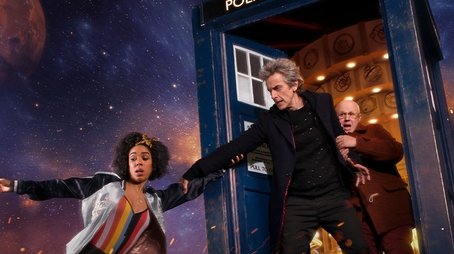
Ask Your Own Question
What is the plot?
The season opens with "The Pilot," where the Doctor, played by Peter Capaldi, is teaching at a university. He meets Bill Potts, a curious and inquisitive student portrayed by Pearl Mackie. Bill is fascinated by the Doctor's lectures on time and space. During a lecture, she notices a strange puddle that seems to have a life of its own. The Doctor, aware of the dangers, tries to keep her away from it. However, Bill's curiosity leads her to investigate further, and she discovers that the puddle is a portal to another dimension.
Bill's life takes a turn when she learns that the Doctor is not just a professor but also a Time Lord with a TARDIS. After a series of events, including a confrontation with a creature from the puddle, Bill is invited to travel with the Doctor. They embark on their first adventure together, visiting the planet of the Mondasian Cybermen, where they encounter a colony of humans who are being transformed into Cybermen. Bill's bravery is tested as she faces the terrifying reality of the Cybermen and their intentions.
In the second episode, "Smile," the Doctor and Bill arrive on a distant planet that appears to be a utopia. They soon discover that the inhabitants, small robotic creatures called Vardies, are programmed to ensure happiness. However, the Vardies are killing humans who express negative emotions. The Doctor and Bill must navigate this dangerous situation, ultimately confronting the Vardies and shutting down their lethal programming. Bill's emotional intelligence and empathy play a crucial role in resolving the conflict.
The third episode, "Thin Ice," takes the Doctor and Bill to Victorian London, where they find a frozen Thames River. They discover a creature beneath the ice that is being hunted by a group of wealthy men. The Doctor and Bill work together to save the creature, which turns out to be a massive whale-like being. The episode explores themes of class and morality, as the Doctor grapples with the ethics of saving the creature while also dealing with the prejudices of the time.
In "Knock Knock," the Doctor and Bill investigate a mysterious house that Bill has moved into with a group of friends. They soon realize that the house is alive and has a sinister connection to the landlord, who is revealed to be a wood-like creature feeding off the life force of the tenants. The Doctor and Bill must work together to save Bill's friends and confront the landlord, leading to a tense showdown where they manage to escape the house's clutches.
The fifth episode, "Oxygen," sees the Doctor and Bill aboard a space station where oxygen is being sold as a commodity. They discover that the crew is being killed off by spacesuits that are programmed to protect the rich while sacrificing the poor. The Doctor and Bill must navigate the dangers of the station, ultimately leading to a confrontation with the suits. Bill's determination to save her friends and the crew drives her actions, culminating in a desperate escape.
In "Extremis," the Doctor is summoned to the Vatican to investigate a mysterious text that predicts the end of the world. He discovers that a group of aliens known as the Monks are manipulating events to gain control over humanity. The episode features a complex narrative structure, including a simulated reality where the Doctor must confront his own mortality. The stakes are raised as the Doctor realizes the Monks' true intentions and the potential consequences for Earth.
The seventh episode, "The Pyramid at the End of the World," continues the story as the Doctor, Bill, and Nardole face the Monks' plan to take over Earth. They find themselves in a pyramid that has appeared in the middle of a war zone. The Doctor must negotiate with the Monks while also dealing with the impending destruction of the planet. Tension builds as the Doctor realizes that the Monks are using fear to manipulate humanity.
In "The Lie of the Land," the Doctor is trapped in a world where the Monks have successfully taken control, and everyone believes their lies. Bill, who has been manipulated into believing the Monks are benevolent, must confront her own beliefs and fight against the oppressive regime. The Doctor, Bill, and Nardole work together to expose the truth and liberate humanity from the Monks' control, leading to a climactic confrontation.
The season's penultimate episode, "The Empress of Mars," takes the Doctor and Bill to Mars, where they encounter a group of Victorian soldiers and the Ice Warriors. The soldiers are being manipulated by the Empress of Mars, who has awakened from her slumber. The Doctor must navigate the political tensions between the soldiers and the Ice Warriors, ultimately leading to a resolution that honors both sides. Bill's growth as a character is evident as she takes on a leadership role in the conflict.
Finally, in "The Doctor Falls," the season culminates in a dramatic showdown. The Doctor faces off against the Cybermen, who have returned in full force. Bill is transformed into a Cyberman, leading to an emotional confrontation between her and the Doctor. The Doctor's internal struggle is palpable as he grapples with the loss of Bill and the consequences of his actions. The episode features a series of intense battles, sacrifices, and revelations, culminating in the Doctor's regeneration. The season ends on a poignant note, with the Doctor reflecting on his choices and the impact of his travels on those he cares about.
What is the ending?
At the end of Doctor Who, Series 10, the Doctor faces the Time Lord's greatest enemy, the Master, who has returned in the form of Missy. The Doctor and his companion, Bill Potts, confront the Cybermen and the threat of the Vault. Bill is transformed into a Cyberman but ultimately finds a way to reclaim her humanity. The Doctor, facing the consequences of his actions, decides to regenerate, leading to a poignant farewell with his companion, Nardole, and a heartfelt moment with Bill, who is now free and in a new form.
As the episode unfolds, we begin with the Doctor, played by Peter Capaldi, and his companion Bill Potts, portrayed by Pearl Mackie, arriving at a desolate landscape where the remnants of a Cyberman army lie. The atmosphere is tense, filled with the remnants of past battles, and the Doctor's demeanor is serious as he prepares for the confrontation ahead. Bill, still grappling with her identity and the implications of her recent experiences, stands beside him, her resolve strengthening.
The scene shifts to the Vault, where Missy, played by Michelle Gomez, is being held. The Doctor has been tasked with keeping her contained, but he is conflicted about her potential for change. Missy expresses a desire to prove herself, and the Doctor, despite his reservations, decides to give her a chance. This moment is charged with emotional weight, as the Doctor grapples with the idea of redemption and the possibility of a former enemy becoming an ally.
As the Cybermen begin to rise, the tension escalates. Bill, who has been transformed into a Cyberman, struggles internally with her new form. The emotional turmoil is palpable as she fights against the programming that seeks to strip away her humanity. In a powerful moment, she manages to connect with the Doctor, revealing her consciousness still exists beneath the Cyberman exterior. The Doctor, filled with determination, vows to help her reclaim her identity.
The climax of the episode occurs when the Doctor, Bill, and Missy confront the Cybermen. The stakes are high, and the battle is fierce. The Doctor's leadership is tested as he navigates the chaos, trying to save Bill while also dealing with Missy's unpredictable nature. The emotional stakes are heightened as Bill's struggle to maintain her humanity becomes a central focus.
In a pivotal moment, Bill is able to break free from the Cyberman programming, transforming back into her human form, but not without consequences. The Doctor witnesses her transformation with a mix of relief and sorrow, knowing that their time together is coming to an end. Bill's newfound freedom is bittersweet, as she realizes the impact of her experiences and the sacrifices made along the way.
As the episode draws to a close, the Doctor faces his own impending regeneration. The emotional weight of his journey culminates in a heartfelt farewell to Bill and Nardole, played by Matt Lucas. The Doctor expresses his gratitude and affection for them, acknowledging the profound impact they have had on his life. Bill, now free and transformed, is given a chance to explore her new existence, while Nardole remains a steadfast companion, ready to face whatever comes next.
The final moments are filled with a sense of closure and new beginnings. The Doctor, standing alone, prepares for his regeneration, reflecting on his past and the adventures that lie ahead. The screen fades to black, leaving viewers with a sense of hope and anticipation for the future, as the Doctor's journey continues in a new form.
Is there a post-credit scene?
In "Doctor Who" Season 10, there is no post-credit scene following the episodes. The season concludes with the two-part finale titled "The Doctor Falls," which wraps up the story arcs and character developments without any additional scenes after the credits. The focus remains on the emotional resolutions and the significant events that transpire in the finale, particularly the fate of the Twelfth Doctor and his companions. The absence of a post-credit scene allows the audience to reflect on the poignant moments and the themes of sacrifice and regeneration that are central to the conclusion of the season.
What is the significance of the character Bill Potts in Series 10?
Bill Potts, played by Pearl Mackie, is introduced as the Doctor's new companion in Series 10. Her character is significant as she represents a fresh perspective, being a university student with a curious mind and a unique background. Bill's journey is marked by her quest for knowledge and understanding, particularly regarding her identity and her feelings for others. Her relationship with the Doctor is built on trust and curiosity, and she challenges him in ways previous companions have not, particularly with her straightforwardness and emotional depth.
How does the Doctor's relationship with Nardole evolve throughout Series 10?
Nardole, portrayed by Matt Lucas, begins the series as a somewhat comedic sidekick to the Doctor, but his character evolves significantly. Initially, he is seen as a caretaker for the Doctor, tasked with keeping him grounded and safe. As the series progresses, Nardole reveals deeper layers, showcasing his loyalty and concern for the Doctor and Bill. His motivations are driven by a sense of duty and friendship, and he ultimately plays a crucial role in the finale, demonstrating his bravery and commitment to the team.
What role does the Monks play in the story arc of Series 10?
The Monks are introduced as a mysterious and manipulative alien race in the three-part story arc beginning with 'The Pyramid at the End of the World.' They present themselves as benevolent beings offering to help humanity, but their true intentions are sinister. They seek to control humanity by manipulating time and reality, leading to a moral dilemma for the Doctor and his companions. The Monks' presence raises questions about free will and the nature of consent, culminating in a tense confrontation that tests the characters' resolve and ethical boundaries.
What is the significance of the 'Empress of Mars' episode in Series 10?
'Empress of Mars' is a pivotal episode that explores themes of colonialism and the consequences of imperialism. The Doctor, Bill, and Nardole arrive on Mars in 1881, where they encounter a group of Victorian soldiers and the Ice Warriors. The episode delves into the Ice Warriors' culture and history, particularly through the character of the Empress, who embodies both strength and vulnerability. The Doctor's interactions with the Empress highlight his role as a mediator and his commitment to understanding rather than conquering, ultimately leading to a resolution that respects both human and Martian lives.
How does the episode 'The Pilot' set the tone for Series 10?
'The Pilot' serves as the introduction to Series 10, re-establishing the Doctor's character and his new dynamic with Bill Potts. The episode begins with the Doctor in a quieter, more reflective state, teaching at a university and trying to lead a normal life. Bill's curiosity and enthusiasm for the universe reignite the Doctor's sense of adventure. The episode also introduces the concept of the 'Vault,' a mysterious locked structure that becomes a recurring element throughout the series. The emotional connection between the Doctor and Bill is central, setting the tone for their relationship and the adventures to come.
Is this family friendly?
"Doctor Who" Season 10, while generally family-friendly, does contain some scenes and themes that may be considered potentially objectionable or upsetting for children or sensitive viewers. Here are some aspects to be aware of:
-
Monsters and Creatures: The season features various alien creatures and monsters that can be frightening, including the return of classic villains like the Daleks and new threats that may evoke fear.
-
Violence and Threats: There are moments of peril where characters face life-threatening situations, including battles and confrontations that may be intense for younger viewers.
-
Death and Loss: Themes of mortality and loss are present, with characters experiencing grief and the consequences of their actions, which may be emotionally heavy.
-
Psychological Horror: Some episodes explore psychological themes and fears, which can be unsettling, particularly for younger audiences.
-
Mature Themes: Certain episodes touch on complex themes such as identity, sacrifice, and moral dilemmas that may require a more mature understanding.
-
Emotional Turmoil: Characters often experience deep emotional struggles, which can be intense and may resonate strongly with sensitive viewers.
While the show is designed to be accessible to a wide audience, parents may want to preview episodes or discuss themes with younger viewers to ensure they are comfortable with the content.











